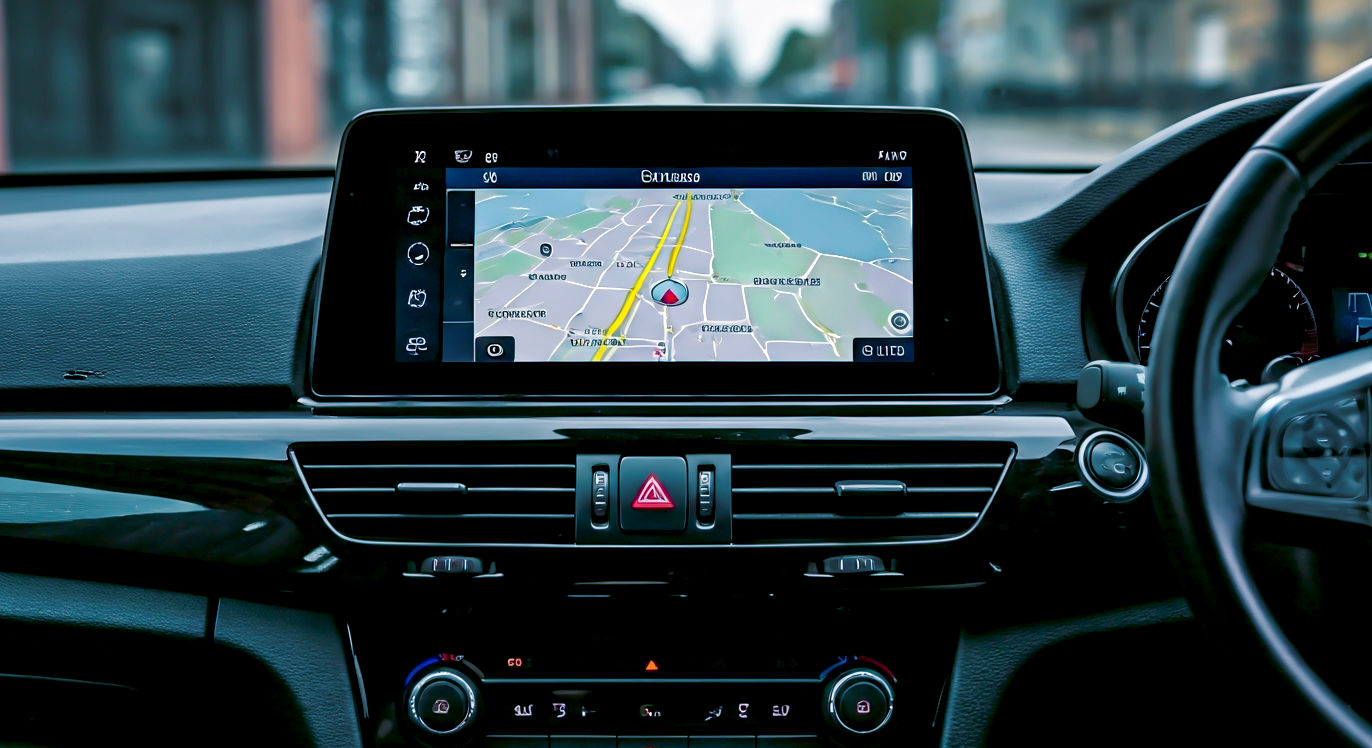The Guide to In-Dash Car Video Systems: A British Driver’s Handbook
The definitive guide for British drivers on choosing, installing, and legally using an in-dash car video system. Everything you need to know is right here.

This post may contain affiliate links. If you make a purchase through these links, we may earn a commission at no additional cost to you.
Ever found yourself wishing you had a screen in your car that did more than just show the radio station? Maybe you’re tired of your phone sliding off the passenger seat while you’re trying to follow a map. Or perhaps you’re just a bit jealous of your mate’s fancy new motor with its slick, built-in screen. Well, you’re not alone. In-dash mounted video systems, often called infotainment systems, are no longer just for high-end cars. They’re becoming a must-have for drivers all over Britain.
But what exactly are they? And with so many options out there, how do you choose the right one? It can feel a bit like trying to pick a new mobile phone – loads of jargon, endless features, and prices that range from “that’s a bargain” to “are you having a laugh?”.
Don’t worry, we’ve got you covered. Think of this as your friendly, no-nonsense guide to the world of in-dash video systems. We’ll walk you through everything, from understanding what they do, to picking the perfect one for your Ford Fiesta or your Range Rover. We’ll even get into the nitty-gritty of installation and the all-important laws you need to know to stay on the right side of the boys in blue. So, buckle up, and let’s get started on upgrading your drive.
What Exactly Are We Talking About? The Lowdown on In-Dash Systems
First things first, let’s clear up what an in-dash mounted video system actually is. You might hear them called all sorts of things: head units, infotainment systems, car stereos, or just “the screen in the dashboard.” Essentially, they’re all talking about the same thing: a device fitted into your car’s dashboard that combines entertainment, information, and other functions into one handy touchscreen.
Think of it as the brain of your car’s media and navigation. It’s the central hub where you can control your music, get directions, make hands-free calls, and sometimes even watch videos (when you’re safely parked, of course!).
So, What’s All the Fuss About?
You might be thinking, “My car already has a radio. Why do I need a fancy screen?” And that’s a fair question. The truth is, these systems offer a lot more than your old-school car stereo.
- Navigation That Doesn’t Get Lost: Gone are the days of printing out directions or balancing your phone on your lap. Modern in-dash systems come with built-in satellite navigation (sat-nav) that gives you real-time traffic updates, helping you dodge those dreaded motorway queues.
- Music and Podcasts on Tap: Whether you’re a fan of Radio 2, a Spotify playlist addict, or love a good podcast on a long drive, these systems make it easy to listen to whatever you want. You can connect your phone via Bluetooth, USB, or use built-in apps.
- Staying Connected Safely: We all know how dangerous it is to use your phone while driving. In-dash systems let you make and receive calls completely hands-free. Many even read your text messages out loud so you can keep your eyes firmly on the road.
- More Than Just the Basics: The best systems do even more. They can connect to reversing cameras to make parking a doddle, link up with your car’s onboard computer to show you things like fuel economy, and even let you browse the internet (again, only when parked!).
A Quick Trip Back in Time: How Did We Get Here?
It might seem like these flashy screens appeared overnight, but the journey has been a long one. Let’s take a quick look back.
In the beginning, there was the car radio. In the 1930s, having a wireless in your car was the height of luxury. Fast forward to the 60s and 70s, and we had cassette players, followed by CD players in the 80s and 90s. Each step was about bringing more of our home entertainment into our cars.
The real game-changer came with the rise of GPS technology. In the late 90s and early 2000s, the first in-car navigation systems started to appear. They were clunky, expensive, and the maps were often out of date, but they were a glimpse of the future.
Then came the smartphone revolution. Suddenly, we had powerful little computers in our pockets that could do everything. Car manufacturers realised they needed to keep up. They started building screens into their dashboards that could connect to our phones, giving us access to our apps, music, and contacts on the move. And that brings us to today, where a high-quality touchscreen is a standard feature in most new cars and a popular upgrade for older ones.
The Different Flavours of In-Dash Systems: Finding Your Perfect Match
Okay, so you’re sold on the idea. You want a shiny new screen in your dashboard. But where do you start? In-dash systems come in a few different shapes and sizes. Let’s break them down.
Single DIN vs. Double DIN: What’s the Difference?
When you start shopping, you’ll see the terms “Single DIN” and “Double DIN” pop up everywhere. This sounds technical, but it’s actually really simple. It’s all about size.
- Single DIN: This is the standard, smaller size for a car stereo slot. It’s about 2 inches tall and 7 inches wide. You’ll find this in many older or more basic cars.
- Double DIN: As the name suggests, this is double the height of a Single DIN unit – about 4 inches tall and 7 inches wide. This is the more common size in modern cars, as it allows for a much larger touchscreen.
How do you know which one you have? The easiest way is to just measure the front of your current car stereo. If it’s about 2 inches tall, it’s a Single DIN. If it’s 4 inches, it’s a Double DIN.
Don’t worry if you have a Single DIN slot. You can still get in-dash video systems for them. Some clever designs have a screen that motors out and flips up. They’re a bit like something out of a James Bond film!
Factory-Fitted vs. Aftermarket: The Big Decision
This is another key choice you’ll face. Do you stick with the system that the car manufacturer put in, or do you buy a new one from a specialist brand like Pioneer, Kenwood, or Sony?
The Pros and Cons of Factory-Fitted Systems
Most new cars today come with a pretty decent in-dash system as standard.
The Good Bits:
- Seamless Integration: It’s designed specifically for your car, so it fits perfectly and works with all the other systems, like the steering wheel controls and the climate control.
- Warranty and Support: If anything goes wrong, you can just take it back to the dealer. It’s all covered under your car’s warranty.
- Familiar Feel: It’s what you’re used to, and it’s all set up and ready to go from the moment you drive off the forecourt.
The Not-So-Good Bits:
- Often Pricey: Car manufacturers can charge a lot for their top-of-the-range systems, especially as part of an options package.
- Limited Features: Sometimes, the built-in systems can be a bit basic compared to the best aftermarket options. They might lack the latest apps or have slower processors.
- Difficult to Upgrade: If you want to add new features later on, it can be difficult or even impossible with a factory-fitted system.
The Pros and Cons of Aftermarket Systems
This is where you buy a new head unit and have it fitted in place of your old one.
The Good Bits:
- Huge Choice: There’s a massive range of aftermarket systems to choose from, so you can find one that has the exact features you want and fits your budget.
- Cutting-Edge Tech: Brands like Pioneer and Alpine are always pushing the boundaries, so you can get the very latest technology, like wireless Apple CarPlay or Android Auto.
- Better Sound Quality: Many aftermarket units have more powerful amplifiers and better audio processing than factory systems, giving you a big upgrade in sound quality.
- Flexibility: You can build a system that’s perfect for you, adding things like better speakers, a subwoofer, or a reversing camera.
The Not-So-Good Bits:
- Can Look Out of Place: While you can get kits to make them fit nicely, some aftermarket units can look a bit “stuck on” compared to a sleek factory-fitted system.
- Potential Compatibility Issues: You might need extra adapters to get it to work with your steering wheel controls or other car systems.
- Installation Can Be Tricky: While it’s possible to do it yourself, fitting an aftermarket system can be a fiddly job. You might be better off getting a professional to do it.
The Must-Have Features: What to Look For in 2025
The world of in-car tech moves fast. What was cutting-edge last year is standard today. So, what are the key features you should be looking for in a new in-dash system?
Apple CarPlay and Android Auto: Your Phone on Your Dashboard
This is, without a doubt, the most important feature to look for. Apple CarPlay (for iPhones) and Android Auto (for Android phones) are clever systems that take the key apps from your phone and display them on your car’s screen in a simple, driver-friendly format.
This means you can:
- Use your favourite navigation apps, like Google Maps, Waze, or Apple Maps.
- Stream music and podcasts from Spotify, Apple Music, BBC Sounds, and more.
- Send and receive messages using your voice. Siri or Google Assistant will read your messages to you and let you reply without taking your hands off the wheel.
- Make calls by simply saying “Call Mum” or tapping their name on the screen.
It’s a much safer and easier way to use your phone’s features in the car. Most systems connect with a USB cable, but some newer, high-end ones now offer wireless CarPlay and Android Auto, which is even more convenient.
Bluetooth: The Hands-Free Hero
Even if a system doesn’t have CarPlay or Android Auto, it absolutely must have Bluetooth. This lets you connect your phone wirelessly for two main things:
- Hands-Free Calling: You can make and receive calls through the car’s speakers and a built-in microphone. This is a legal requirement if you want to talk on the phone while driving in the UK.
- Audio Streaming: You can play music from your phone through the car stereo without any cables.
A Great Screen: Your Window to the World
The screen is what you’ll be looking at and touching all the time, so it needs to be good. Here’s what to consider:
- Size: Bigger is generally better, as it makes it easier to see maps and press on-screen buttons. Most Double DIN units have screens between 6.5 and 9 inches.
- Resolution: A higher resolution means a sharper, clearer picture. Look for something that’s at least 800×480 pixels.
- Touchscreen Type: There are two main types. Resistive screens are the older style, which you have to press quite firmly. Capacitive screens are what you find on modern smartphones – they’re much more responsive and support multi-touch gestures like pinching to zoom on a map. Always go for a capacitive screen if you can.
- Brightness and Anti-Glare: The screen needs to be bright enough to see clearly on a sunny day, and it’s a bonus if it has an anti-glare coating to reduce reflections.
Other Nifty Features to Consider
- DAB Radio: AM and FM radio are still around, but DAB (Digital Audio Broadcasting) is the future. It gives you a much wider choice of stations (like BBC Radio 6 Music and Absolute 80s) and crystal-clear, hiss-free sound. Most new systems come with DAB as standard.
- Reversing Camera Input: This is a fantastic safety feature. It’s a port on the back of the head unit that lets you connect a small camera on the rear of your car. When you put the car in reverse, the camera’s view automatically appears on the screen, making parking in tight spots a breeze.
- USB and SD Card Slots: Useful for playing music or videos from a USB stick or memory card. Some can also be used to charge your phone.
- Built-in Sat-Nav: While you can use apps like Google Maps through CarPlay and Android Auto, some people prefer to have a dedicated, built-in navigation system that works even if you don’t have a phone signal. These often come with detailed maps of the UK and Europe.
The Legal Side of Things: Staying Safe and on the Right Side of the Law
This is a really important bit, so listen up. Having a screen in your car is great, but it also comes with responsibilities. The law in the UK is very clear about using screens and phones while driving.
The Golden Rule: Don’t Touch It While Driving!
As of 2022, the law was toughened up. It is now illegal to hold and use a phone, sat-nav, tablet, or any other device that can send or receive data, while driving or riding a motorcycle. This means you can’t touch the screen to type in a destination, browse a playlist, or reply to a message while you’re on the move.
The only exception is if your device is in a hands-free cradle, but even then, you can only touch it for essential functions like accepting a call.
The penalty for breaking this law is severe: 6 penalty points on your licence and a £200 fine. If you’ve only been driving for two years or less, that means you’ll lose your licence completely.
So, how do you use your shiny new in-dash system legally?
- Set everything up before you drive. Put your destination into the sat-nav and choose your playlist before you even pull away from the kerb.
- Use voice commands. Apple CarPlay and Android Auto are brilliant for this. You can ask Siri or Google Assistant to do almost anything without taking your hands off the wheel.
- Use your steering wheel controls. If your car has buttons on the steering wheel, you can use them to answer calls, change the volume, or skip tracks.
- If you absolutely have to touch the screen, pull over somewhere safe. It’s just not worth the risk.
What About Watching Videos?
The law is also very clear on this. A screen that can display videos or TV shows must not be visible to the driver while the vehicle is moving.
Most in-dash systems that can play videos have a safety feature that links to the handbrake. The video will only play when the handbrake is on. It’s illegal (and very silly) to try and bypass this feature. The screen can, however, be used for navigation or to show information about the car.
Getting It Fitted: DIY or Call in the Pros?
You’ve done your research, you’ve chosen your perfect system, and it’s just been delivered. Now comes the moment of truth: installation.
The DIY Route: For the Brave and the Bold
If you’re handy with a screwdriver and comfortable with a bit of car electronics, you might fancy having a go at fitting it yourself. It can be a rewarding job, and it’ll save you a bit of cash.
What you’ll need:
- The Head Unit: Obviously!
- A Fascia Adapter: This is a plastic trim piece that fills any gaps around the new unit, making it look neat and tidy in your dashboard.
- A Wiring Harness Adapter: This is a crucial bit of kit. It plugs into your car’s existing wiring on one end and the new head unit on the other. This means you don’t have to cut any of your car’s original wires.
- An Aerial Adapter: You might need this to connect your car’s radio aerial to the new unit.
- Tools: You’ll typically need a set of screwdrivers, some trim removal tools (to avoid scratching your dashboard), and possibly some wire strippers and crimpers.
The Basic Steps:
- Disconnect the Battery: This is a vital safety step. Always disconnect the negative terminal of your car’s battery before you start fiddling with any electronics.
- Remove the Old Stereo: This usually involves carefully prising off some of the dashboard trim and then undoing a few screws.
- Connect the Wiring Harness: Connect the adapter to your car’s wiring and then to the new head unit.
- Connect Everything Else: Plug in the aerial, the microphone for hands-free calling, and any other accessories.
- Test It: Reconnect the battery temporarily and turn the ignition on to make sure everything works before you screw it all back into place.
- Fit the New Unit: Secure the new unit in the dashboard, fit the fascia adapter, and put all the trim back.
There are loads of great tutorials on YouTube that can walk you through the process for your specific car model. Just take your time, be patient, and double-check everything.
The Professional Route: Sit Back and Relax
If the thought of all that wiring brings you out in a cold sweat, there’s absolutely no shame in getting a professional to fit it for you. In fact, for most people, it’s the sensible choice.
A good car audio installer will have all the right tools and years of experience. They’ll know exactly which adapters you need for your car and will have the whole job done in an hour or two. They’ll also be able to hide all the wires neatly and make sure everything is working perfectly.
Where can you find a good installer?
- Halfords: They offer a professional fitting service for car stereos bought in their stores.
- Independent Car Audio Specialists: A quick search online for “car audio installation near me” will bring up local experts. They’re often real enthusiasts who do a fantastic job.
You can expect to pay anywhere from £50 to £150 for professional installation, depending on the car and the complexity of the job. It’s money well spent for peace of mind.
The Future is Now: What’s Next for In-Dash Tech?
The technology in our cars is evolving at an incredible pace. So, what does the future hold for the humble dashboard screen?
- Bigger, Better Screens: Expect to see even larger, higher-resolution screens, some even stretching right across the dashboard. OLED technology, like that used in high-end TVs, will make for stunning colours and deep blacks.
- Smarter Integration: Cars will become even more connected. Your in-dash system will talk to your smart home, so you can turn on the heating before you get home. It will also connect to other cars and city infrastructure to warn you about accidents or traffic jams ahead.
- Augmented Reality (AR): This is a really exciting one. AR navigation will overlay directions directly onto a live video feed of the road ahead, so you’ll never miss a turning again.
- Personalised Experiences: The system will recognise who is driving and automatically adjust the seat, mirrors, music, and climate control to their preferences.
It’s all moving towards a future where our cars are not just a way to get from A to B, but a fully connected, personalised part of our digital lives.
Your In-Dash System Checklist: A Quick Summary
Feeling a bit overwhelmed? Don’t be. Here’s a simple checklist to help you choose the right system.
- Check Your Size: Is your car Single DIN or Double DIN?
- Prioritise Connectivity: Make sure it has Apple CarPlay or Android Auto. This is the most important feature.
- Don’t Forget Bluetooth: Essential for legal, hands-free calling and music streaming.
- Look for a Good Screen: Aim for a large, bright, capacitive touchscreen.
- Get Digital Radio: DAB is a must for a wide choice of stations and clear sound.
- Consider a Reversing Camera: It’s a brilliant safety and convenience feature.
- Set Your Budget: You can get a good system for a few hundred pounds, but the sky’s the limit for the top-end models.
- Plan Your Installation: Decide if you’re going to tackle it yourself or pay a professional.
- Know the Law: Remember, never touch the screen while you’re driving. Use voice commands or pull over.
An in-dash video system can truly transform your driving experience, making it safer, more convenient, and a lot more enjoyable. By doing a bit of research and choosing the right features for you, you can bring your older car right up to date and make every journey that little bit better. Happy driving!
Further Reading
For those who wish to delve deeper, here are some highly respected UK-based resources:
- What Car?: A trusted source for car reviews and consumer advice, with detailed looks at the latest infotainment systems.
- Auto Express: Offers news, reviews, and group tests on all things automotive, including in-car technology.
- The RAC and The AA: Both organisations provide essential guidance on UK driving laws, including the rules around mobile phone and screen use in cars.
- Car Audio Direct: A major UK retailer of aftermarket systems, their website is a good place to browse the latest products from top brands.






